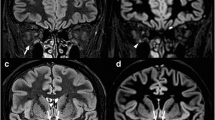Summary
Orbital fat surrounding the optic nerve causes considerable difficulties in NMR imaging due to its high image intensity and the chemical shift artefact. We have investigated the ability of inversion recovery seqeunces with short inversion times (STIR sequences) to suppress fat signals in imaging the optic nerve. We have also compared the contrast attainable with STIR sequences with that obtainable from other sequences. Measurements were made on 4 normal controls and 5 patients with multiple sclerosis (MS) to obtain typical values of relaxation times and proton densities for orbital fat, cerebral white matter and MS lesions. The fat T1 measurements were used to predict an appropriate inversion time for the STIR sequence and estimate how much residual fat signal might be expected as a result of natural variations in fat T1. STIR sequences can be used to suppress the signal from orbital fat with little residual signal. Measurements from white matter and MS lesions were used to predict the contrast between normal and pathological tissues that is attainable with STIR sequences. STIR contrast compares favourably with that obtainable from other sequences.
Similar content being viewed by others
References
Haase A, Frahm J, Hanicke W, Matthaei D (1985) H NMR chemical shift selective (CHESS) imaging. Phys Med Biol 30: 341–344
Joseph PM (1985) A spin echo chemical shift MR imaging technique. J Comput Assist Tomogr 9: 651–658
Dixon WT (1984) Simple proton spectroscopic imaging. Radiology 153: 189–194
Sepponen RE, Sipponen JT, Tanttu JI (1984) A method for chemical shift imaging: demonstration of bone marrow involvement with proteon chemical shift imaging. J Comput Assist Tomogr 8: 585–587
Bydder GM, Young IR (1985) MR imaging: clinical use of the inversion recovery sequence. J Comput Assist Tomogr 9: 659–674
Young IR, Bailes DR, Bydder GM (1985) Apparent changes of appearance of inversion-recovery images. Magn Reson Med 2: 81–85
Hearshen D, Ellis J, Carson P, Shreve P, Aisen A (1984) Boundary effects from phase cancellation in inversion recovery images. Book of Abstracts, 3rd Annual Meeting, Society of Magnetic Resonance in Medicine, New York, p 310. Society of Magnetic Resonance in Medicine, Berkeley
Ortendahl DA, Hylton N, Kaufman L, Watts JC, Crooks LE, Mills CM, Stark DD (1984) Analytical tools for magnetic resonance imaging. Radiology 153: 479–488
Johnson G, Ormerod IEC, Barnes D, Tofts PS, MacManus D (1986) Accuracy and precision in the measurement of relaxation times in NMR imaging. Brit J Radiol (In press)
Poser CM, Paty DW, Scheinberg L, McDonald WI, Davis FA, Ebers GC, Johnson KP, Sibley WA, Silberberg DH, Tourtellotte WW (1983) New diagnostic criteria for the clinical diagnosis of multiple sclerosis: Guidelines for research protocols. Ann Neurol 13: 227–231
Ormerod IEC, Bronstein A, Rudge P, Johnson G, MacManus D, Barratt H, Halliday AM, du Boulay EPGH, Kendall BE, Moseley IF, Jones SJ, Kriss A, Perringer E (1986) Nuclear magnetic resonance imaging of the brain stem. J Neurol Neurosurg and Psychiatry 49: 737–743
Tourtellotte WW, Parker JA (1968) Some spaces and barriers in postmortem multiple sclerosis. Lajtha A, Ford DH (eds) Brain Barrier Systems, Progress in Brain Research 29, 493–525 Amsterdam: Elsevier 1968
Bakker CJG, Vriend J (1984) Multi-exponential water proteon spin-lattice relaxation in biological tissues and its implications for quantitative NMR imaging. Phys Med Biol 29: 509–518
Miller D, Johnson G, McDonald WI, MacManus D, du Boulay EPGH, Kendall BE, Moseley IF (1986) Detection of optic nerve lesions in optic neuritis with magnetic resonance imaging. Lancet. 28: 1492
Author information
Authors and Affiliations
Rights and permissions
About this article
Cite this article
Johnson, G., Miller, D.H., MacManus, D. et al. STIR sequences in NMR imaging of the optic nerve. Neuroradiology 29, 238–245 (1987). https://doi.org/10.1007/BF00451760
Received:
Issue Date:
DOI: https://doi.org/10.1007/BF00451760




